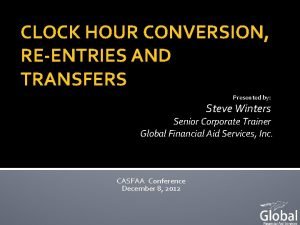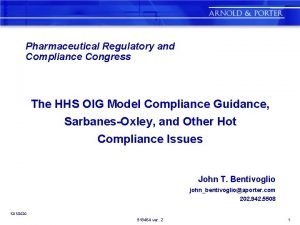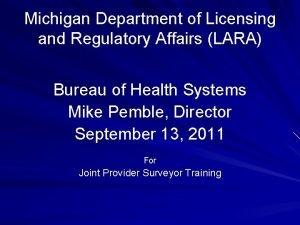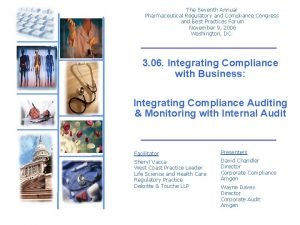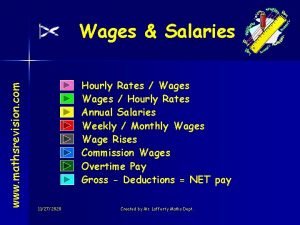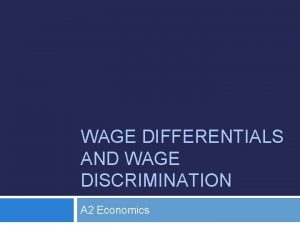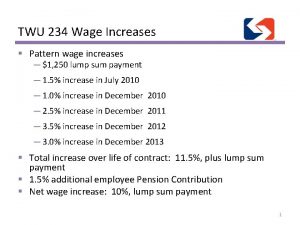Regulatory Changes to Wage Hour Law and Strategies
























- Slides: 24

Regulatory Changes to Wage & Hour Law and Strategies on How to Efficiently Respond PRESENTED BY: BRIAN KOJI ALLEN, NORTON & BLUE, P. A. MAY 18, 2016

An Overview �Dept. of Labor’s final rule changes released earlier today will impact overtime pay These changes will substantially increase minimum salary requirements for exempt employees The proposed minimum salary will be recalculated periodically to ensure that the salary level keeps up with inflation The changes go into effect on December 1, 2016

Current Standard �White Collar Exemptions: Exemption allows an employer to exclude certain executive, administrative, and professional employees from the federal minimum wage and overtime requirements To qualify for the exemption an employee generally must: � Be paid on a salary basis and not on an hourly basis (except for certain professionals) � Earn more than $455/week ($23, 660 annually) � Perform primarily executive, administrative, or professional duties as defined under the DOL regulations

Current Standard �Highly Compensated Employee Exemption: This exemption applies to employees earning salary of over $100, 000 To qualify for the HCE exemption an employee must: � Earn at least $100, 000 annually An employer could pay the employee a year end bonus to allow them to qualify for the exemption � Take home at least $455/week paid on a salary or fee basis � Perform duties consisting primarily of office or non-manual work � Customarily and regularly perform at least one of the exempt duties of an exempt administrator, professional, or executive

Job Duties Component of Exemptions The final DOL regulation DOES NOT impose any changes to the job duties requirements of the white-collar exemptions. To be exempt, employees must still meet those requirements in addition to the new minimum salary requirements � The DOL had previously requested comments regarding possible changes to the job duties component of the exemption, but did not ultimately impose any changes

Changes Imposed by DOL �White Collar Exemptions – Salary Increase The DOL’s changes to the regulations would essentially double the minimum salary requirements applicable to the executive, administrative and professional exemptions � As of December 1, 2016, the minimum salary amount for exempt employees is $913/weekly or $47, 476 annually (an increase from $455/weekly or $23, 660) � This is a change from the proposed regulation issued last year, which initially proposed $50, 440 per year ($970 weekly)

Changes Imposed by DOL �Highly Compensated Employees For HCE, the changes increase the minimum salary requirements from $100, 000 to $134, 004 annually To calculate this number, the DOL used the 90 th percentile of earnings for all full-time salaried workers � The DOL did not include a projected calculation for 2016 in the proposed rule issued in 2015, but did calculate the amount for 2013 at $122, 148.

Automatic Periodic Salary Updates The new minimum salary is the amount equivalent to the 40 th percentile of the weekly earnings of all full-time non-hourly workers in the lowest-wage Census Region as published by the Bureau of Labor Statistics Beginning on Jan. 1, 2020, and every three years thereafter, the DOL will update (i. e. , raise) the minimum salary based on the 40 th percentile figure reported in the second quarter of the preceding year Similarly, the HCE salary will likewise be updated on the same schedule

Automatic Annual Salary Updates The DOL regulation requires the three-year updated minimum salary level be calculated and published at least 150 days prior to becoming effective on January 1 of the next year � Designed to prevent minimum salary from becoming outdated � This is a change from the 2015 proposed regulation, which initially proposed annual updates Automatic annual updating was proposed in the 1970 and 2004 rulemaking, but the DOL did not adopt it until now This is an aspect of the rule that could be subject to court challenges

Non-Discretionary Bonuses and Incentive Pay �The DOL’s final rule also permits employers to satisfy the minimum salary by using non-discretionary bonuses and incentive payments, such as bonuses tied to productivity and profitability (including commissions), to count toward 10% of the minimum weekly salary level for the executive, administrative, and professional exemptions. � This is new. The prior rule only permitted this for the Highly. Compensated Employee exemption

Non-Discretionary Bonuses and Incentive Pay To be counted toward the minimum salary, the bonus or incentive pay must: � Be non-discretionary; and, � Paid to the employee at least quarterly or a more frequent basis. If bonuses or incentive payments in a 13 -week quarter are insufficient to satisfy the minimum salary requirement, the employer is permitted to make a supplemental payment in the first pay period of the next pay period to make up the difference � Of course, the supplement payment cannot count toward the minimum needed for that subsequent quarter

Impact of Changes The DOL estimates that after these rules become effective, 4. 2 million exempt employees will become non-exempt, including 313, 000 in Florida The DOL estimates that the rule change will result in “direct employer costs” between $239. 6 million and $255. 3 million per year The DOL further estimates that the rule will also result in the transfer of income from employers to employees in the range of $1. 18 billion to 1. 27 billion per year

Practical Tips – What to Do Now �While the Final Rule does not become effective until December 1, 2016, employers must take action now to prepare �Employers should take this opportunity to review its wage and hour practices and prepare to make changes to comply with the new regulations and to ensure compliance with existing rules

Available Options for Currently-Exempt Employees Earning Less than New Minimum Salary 1. Raise employee’s salary to the new minimum or higher and maintain exemption 2. Maintain employee’s current salary and pay overtime at 1. 5 regular rate 3. Convert the employee to non-exempt status, but limit the employee’s hours to 40 or less 4. Convert the employee to non-exempt status, but adjust the employee’s rate of pay so that base pay and anticipated overtime compensation approximates prior salary 5. Convert the employee to non-exempt status, but pay a guaranteed salary based on employee’s normal schedule (if other than 40 hour workweek) 6. Convert the employee to non-exempt status, but pay overtime based on fixed salary for fluctuating workweek 7. Reorganize job duties and responsibilities

Available Options– Maintaining the Exemption �Conduct an audit of affected exempt employees: How many currently exempt employees make less than $47, 476? � How many of those make just under the minimum? � How many make far below the minimum? � How many make just over the minimum? � How many hours does the employee work? Should employees making under the minimum be afforded salary increases (potentially every three years) to keep them exempt or should they be converted to non-exempt? � What about employees in similar positions, some of whom are above the minimum salary and some of whom are below it?

Available Options– Converting Employees to Non. Exempt Status �For employees who will be converted to non-exempt: Do you know how many hours the employee is working (including any hours worked at home, on weekends, etc. )? The employer must begin tracking the employee’s actual time worked and computing overtime accordingly. Anticipate “morale” problems (i. e. , perceived demotion by employee –now is the time to blame the government). Should scheduling and working practices be adjusted to minimize overtime worked? Policies should be reviewed to keep employees from working off the clock.

Available Options– Converting Employees to Non-Exempt Status �For employees who will be converted to non-exempt: Decide whether to pay the non-exempt employee on an hourly basis or to continue to pay a salary (plus overtime) � You can still pay a salary to a non-exempt employee, but you must supplement the salary if the employee works over 40 hours � Salary acts as a minimum compensation amount Example (Salary based on 40 hours) � Employee earns $1000 per week in guaranteed salary, which is based on 40 hours. During the workweek, the employee works 50 hours. The employee must be paid his $1000 salary plus $375 in overtime compensation ($1000 divided by 40=$25 regular rate; $25 at 1. 5 OT rate for 10 hours equals $375 in overtime) This is the same as paying $25 per hour, with a minimum guarantee

Available Options– Converting Employees to Non-Exempt Status Example (Salary based on 50 hours) � Employee earns $1000 per week in guaranteed salary, which is based on 50 hour schedule. During the workweek, the employee works 55 hours. � The employee must be paid his $1000 salary plus $250 in overtime compensation ($1000 divided by 50=$20 regular rate). For hours 40 -50, employees is only entitled to half-time rate ($10 x 10 hours=$100). For hours 50 -55, the employee is entitled to time-and-a-half rate ($30 x 5 hours=$150) � Should have written documentation as to how many hours the salary is meant to compensate � Be careful with deductions from salary level, more strict than for exempt employees.

Available Options– Converting Employees to Non-Exempt Status Example (Salary based on fluctuating workweek) � Employee earns $1000 per week in guaranteed salary, which is based on “all hours worked, ” which tends to fluctuate for the employee. � Assume, during week 1, the employee works 50 hours. The employee is entitled to his weekly salary of $1000, plus $100 in overtime compensation. The regular rate is $20 ($1000 divided by 50). The employee then gets overtime for 10 hours at half-time rate ($10 for 10 hours). � Assume in week 2, the employee works 55 hours. The employee is entitled to his weekly salary of $1000, plus $136. 35 in overtime compensation. The regular rate is $18. 18 ($1000 divided by 55). The employee then gets overtime for 15 hours at half-time rate ($9. 09 for 15 hours =$136. 35) � Should have written documentation detailing that the salary is meant to compensate for all hours worked each week, regardless of number � Be careful with deductions from salary level, more strict than for exempt employees.

Available Options – Reducing Base Pay and Paying Overtime Compensation �For employees who will be converted to non-exempt: You can also reduce the non-exempt employee’s pay rate so that, with overtime compensation, the total compensation is equivalent � EXAMPLE: Assume an exempt employee normally works 50 hours per week earning a weekly salary of $800 (i. e, $41, 600/year and $16/hr) � If you convert to non-exempt and did not change the compensation rate ($16/hr), the employee would receive $880/wk ($45, 760) after being paid overtime for the ten OT hours worked each week. � However, if you reduce the employee’s hourly rate to $14. 55/hr, the employee’s total weekly compensation with overtime is $800. 25 ($14. 55 x 40 straight-time hours plus $14. 55 x 10 OT hours)

Practical Tips �Once you identify if the regulatory changes affect you, you should consider the following: Will you reduce hours to avoid overtime? Will you reorganize employees? If you reduce hours, will you be required to hire more workers? Anticipate employee morale issues (need to have clear message and plan of action to convey the plan to affected employees) Should you educate newly-nonexempt employees whose wage rates have been lowered but whose total pay should not be adversely affected (consider comparison pay sheets with actual paystubs) � Consider doing comparison sheets now, before effective date

More Practical Tips Policies � How will you implement and communicate new policies for tracking hours worked? � Will you implement new policies to reduce off-the-clock exposure? Access to computer networks, email, company-paid mobile devices Consider whethere are there collective bargaining obligations with a union, particularly where you are changing pay rates, schedules, etc. ? Consider involving attorneys in wage and hour audit process � Attorney/Client privilege can be asserted

What Not To Do Don’t stick your head in the sand until December 1! Don’t convert employees to independent contractors Don’t just assume newly-nonexempt employees only work 40 hours Don’t assume all employees who make over minimum salary are exempt (still must satisfy duties test) Don’t raise salaries to satisfy new exemption amount and then make impermissible deductions to save money

Questions? � Don’t panic! � Contact your Allen Norton & Blue attorney with questions and for guidance! ANB Miami Office -- (305) 445 -7801 ANB Orlando Office – (407) 571 -2152 ANB Tampa Office – (813) 251 -1210 ANB Tallahassee Office – (850) 561 -3503
 Pharmacy law ethics and regulatory agencies
Pharmacy law ethics and regulatory agencies Newton's first law and second law and third law
Newton's first law and second law and third law Newton's first law of motion
Newton's first law of motion 24hr time
24hr time Semester vs trimester
Semester vs trimester Changes in latitudes, changes in attitudes meaning
Changes in latitudes, changes in attitudes meaning Example of chemical change
Example of chemical change V=k/p
V=k/p Boyle's law charles law avogadro's law
Boyle's law charles law avogadro's law What is a wage
What is a wage Concept of wage and salary administration
Concept of wage and salary administration What is a wage
What is a wage Wage and workplace standards ct
Wage and workplace standards ct Chapter 22 regulatory and advisory agencies
Chapter 22 regulatory and advisory agencies Diversity and regulatory challenges
Diversity and regulatory challenges Warehousing development and regulatory authority
Warehousing development and regulatory authority Pharmaceutical regulatory and compliance congress
Pharmaceutical regulatory and compliance congress Michigan department of licensing and regulatory affairs
Michigan department of licensing and regulatory affairs Legal regulatory and political issues
Legal regulatory and political issues Pharmaceutical regulatory and compliance congress
Pharmaceutical regulatory and compliance congress Legal and regulatory framework of microfinance in india
Legal and regulatory framework of microfinance in india Pharmaceutical regulatory and compliance congress
Pharmaceutical regulatory and compliance congress Pharmaceutical regulatory and compliance congress
Pharmaceutical regulatory and compliance congress Mathsrevision.com
Mathsrevision.com What is a wage
What is a wage




